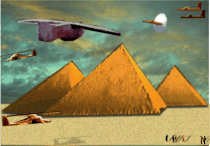Dinosaurs in Literature, Art & History-- Page 7
Man and Dinosaur Co-existence
Ancient Zoomorphic Vase Depicts Flat Headed Dinosaur?
Did He Live Millions of MINUTES Ago?
 Photo:left: The ancient piece in question. A flat headed dino?
Photo:left: The ancient piece in question. A flat headed dino?
Click and drag photo to resize. Script from The Java Script Source
The "flat headed" dinosaurs were very common. They came in large varieties that fall into different groups. The item on the top left is an ancient "zoomorphic" vase thought to be at least 2000 years old of either ancient Roman but more probably Mycenean manufacture. The Mycenean civilization's fall is thought to have taken place between 1300 and 1000 years before Christ.
The item is called zoomorphic because it is recognized that an animal figure is being represented--but which animal is unknown. Often "mythological" animals are identified as zoomorphic.

The main photo is 1998 from the Archaeological Institute of America. Its immediately recognizable as one of a type of the Flat headed dinosaurs which I believe existed at the time the artist made this piece.
It has been our contention that these animals and man co-existed in the past and in the recent past. If these animals and man did co-exist, we should expect to see representations of them in art of the times just as we see with other animals they lived with.
Fossils of flat headed dinosaurs are very common. As the principal function of the object is a vase, it is not an exact representaion, but I believe it shows the same curve of belly and tail as well as the head shape perculiar to this type of dinosaur, with back legs thicker than the front legs.
I've included a selection of hydrosaurs on this page of various types (corresponding to the poll) which to me seem most likely to be what the ancient craftsman intended to represent with this zoomorphic vase.
What do you think?







Hadrosaurs
"Hadrosaurs are some of the best known and most diverse (many different species) types of dinosaurs. There have even been large skin impressions found showing that hadrosaurs had small, button-like scales all over their bodies.
They seem to be the deer of the Late Cretaceous. They were probably the prey of choice of the large meat-eating dinosaurs (the tyrannosaurs). They divide into two different groups, with the biggest difference between the groups being what their head looks like.
The heads of the hadrosaurines were flat or had small spikes on the top.
The heads of the lambeosaurines had big crests on them. Hadrosaurs had the most complicated, best designed teeth of all of the plant eating dinosaurs.
They had up to 1200 teeth in their mouth at the same time. With all of these teeth, they could chew any plant material. This made them very successful as a group.
Hadrosaurines
Some had very wide mouths with very long, flat heads (edmontosaurs), some had little spikes on the tops of their heads (saurolophs), and some had bumps on their noses (gryposaurs).
It was the discovery of the hadrosaur Maiasaura that let palaeontologists know that hadrosaurs looked after their young in nests. Eggs, babies, and nests of Maiasaura were all found in the late 1970's in Montana showing a little bit about how baby dinosaurs grew up. Huge bonebeds have been found for several of the hadrosaurs, often with 10,000 or more different dinosaurs in each!
Hadrosaurines ranged from 8 meters (Gryposaurus) to about 15 meters (Shantungosaurus) in length. They have been found in Asia, South America, North America, and Europe.
True hadrosaurs include Gryposaurus, Maiasaura, Prosaurolophus, Shantungosuarus, Edmontosaurus, Saurolophus, Brachylophosaurus, Anatotitan, and Hadrosaurus."
Source:Dinoguy

1, 2, 3, 4, 5, 6, 7, 8, 9, 10
11, 12, 13, 14, 15, 16
17 18, 19,
20,
21,
22,
23,
24,
25,
26,
27,
28,
29,
30,
31,
32,
33,
34,
35,
36,
37,
38,
39,
40,
41,
42,
43,
44,
45,
46,
47
Next>>>


 Home
Home 20th Century Dinosaurs
20th Century Dinosaurs Dinosaurs in Literature, Art & History
Dinosaurs in Literature, Art & History Eyewitness Accounts
Eyewitness Accounts There Were Giants In The Earth in Those Days
There Were Giants In The Earth in Those Days Mega Fauna
Mega Fauna Those Sophisticated "Cave Men"
Those Sophisticated "Cave Men" Search for Noah's Ark
Search for Noah's Ark DNA, The Ultimate Oopart
DNA, The Ultimate Oopart The Bone Yards
The Bone Yards Underwater Cities, Monuments?
Underwater Cities, Monuments? Ancient Atomic Knowledge?
Ancient Atomic Knowledge? Salvation. What Must You Do To Be Saved?
Salvation. What Must You Do To Be Saved? Search
Search Links
Links Guestbook
Guestbook Photo:left: The ancient piece in question. A flat headed dino?
Photo:left: The ancient piece in question. A flat headed dino? 




